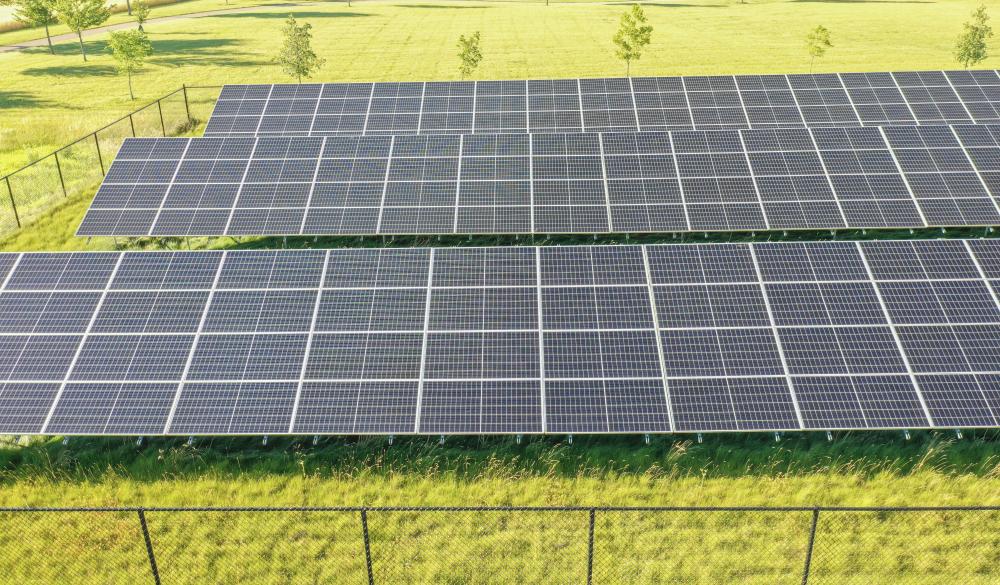Mike Mullett strains to see through sheets of misty rain while driving through working-class neighborhoods of Columbus, a quaint town in southern Indiana.
He’s trying to find the senior center, multi-family homes and rent-assisted properties – more than 530 in total – that he and many other locals hope will receive $4.42m in federal funding for solar electricity projects.
But now that money is at risk.
On 20 January, Donald Trump paused billions of dollars of federal grant funding for clean energy and other projects around the country initiated by the Biden administration’s Green New Deal.
“We’ve been slavishly working on a plan since April 2023 that would provide solar energy to hundreds of households in two low- and moderate-income Columbus neighborhoods,” says Mullett. The project was expected to be rolled out in April, with previously approved funding thought to have been made available by 14 February.
“Unless the Trump administration makes a 180-degree turn on funding, that expectation will obviously not be met.”
Related: Record-breaking growth in renewable energy in US threatened by Trump
The funding is part of the US Environmental Protection Agency’s $7bn Solar for All program, which is meant to help low-income families save money on electricity costs. About $117m was set for solar projects and initiatives in Indiana.
Communities across Indiana, a solidly Republican midwestern state, were set to benefit more than most from the Biden administration’s ambitious clean energy push in what was an ultimately failed effort to win votes in Rust belt states whose voters have abandoned Democratic party politicians in recent decades.
By August 2024, $7.8bn in private investment for a host of clean energy projects including solar and battery production had come to Indiana, spurred in part by the promise of federal grants and local tax-abatement schemes.
But Trump has followed through on his election campaign promise to roll back clean energy initiatives, referring to Biden’s efforts as the “Green New Scam”.
Leading Republicans have backed his move, despite the potential economic risks to states where the president is popular.
“The executive branch of government in our system has the right to evaluate how executive branch agencies are operating,” the Republican House speaker, Mike Johnson, said on 5 February.
On 10 February, a federal judge issued an order for the Trump administration to unfreeze its funding hold.
Indiana isn’t alone in its drive for solar energy.
Solar projects ranging from utility scale to single housing efforts have proved hugely popular in red states. Texas has the second-highest number of installed solar power units, after California, enough to power more than 4.5m homes. Florida follows close behind.
A quarter of a trillion dollars – 80% of the total funding for green energy manufacturing and other initiatives – was to go to projects in Republican-leaning congressional districts across the US.
At 3.4% of its total, Indiana, where Trump won by almost 19 points in November’s presidential election, produces more state electricity from solar than Democrat-leaning states such as Illinois, Washington and New Hampshire, according to one industry organization.
“The $130m in total Solar for All funding awarded for Indiana would transform Indiana’s solar market by allowing more than 10,000 families in low-income communities around the state to directly benefit from the electric bill savings and resilience afforded by local solar,” says Zach Schalk, the Indiana program director at Solar United Neighbors Action, a non-profit that has helped invest $7.1m in solar initiatives in the state.
“It’s really a non-partisan issue if you look at the survey polling across the US. We’ve had elected officials of both parties [in Indiana] sign letters of support. We know that this is a popular program.”
But some question the importance of federal dollars in fueling solar’s growth at the utility scale, and more broadly its ability to meet the enormous demand for electricity.
“I’ve had a number of the solar [utility] companies in and in many instances they are saying that [the tax rebates and other federal funding] are nice, but the industry has matured quite a bit [to the extent] that they still have enough [profit] margin without it,” says Indiana Republican representative Ed Soliday, who has backed laws supporting solar initiatives in the state.
“What’s shaking out is that commercial solar is advancing far more than the rooftop equivalent. You can’t run a manufacturing plant on rooftop solar panels.”
Emails sent to the Indiana Republican party and a state senator representing Columbus asking if party members believed the funding pause could risk solar electricity projects and disrupt business developments were not responded to.
In Columbus, Trump’s move has been demoralizing for Mullett and others who have made a huge effort to secure funding that would see solar electricity infrastructure installed at 320 community households, 204 multi-family households and seven single-family project households.
“Most of us are retirees and volunteers,” he says. “I would say [we’ve spent] 20 hours a week at a minimum; sometimes there were weeks when we were doing 40 to 60 hours a week.”
He says that if the federal funding is lost, private funding that has been committed to help pay for the project would be gone too.
“If the pending litigation in federal district courts must run its course all the way to the US supreme court, the delay in the rollout of the [funding] would certainly be measured in months, perhaps extending even into 2026,” he says.
According to one study, Indiana residents have seen the seventh-highest electricity rate increase in the country. Nearly 83% of its electricity generation is sourced by natural gas or coal plants.
Still, the time and effort Mullet and other community members have invested in the project means they aren’t about to give up. He says the work will continue even as the funding remains in flux.
“Doing this in a way that low-income households can become involved, it’s literally a 50-year-old dream of mine,” he says.
Read the full article here
